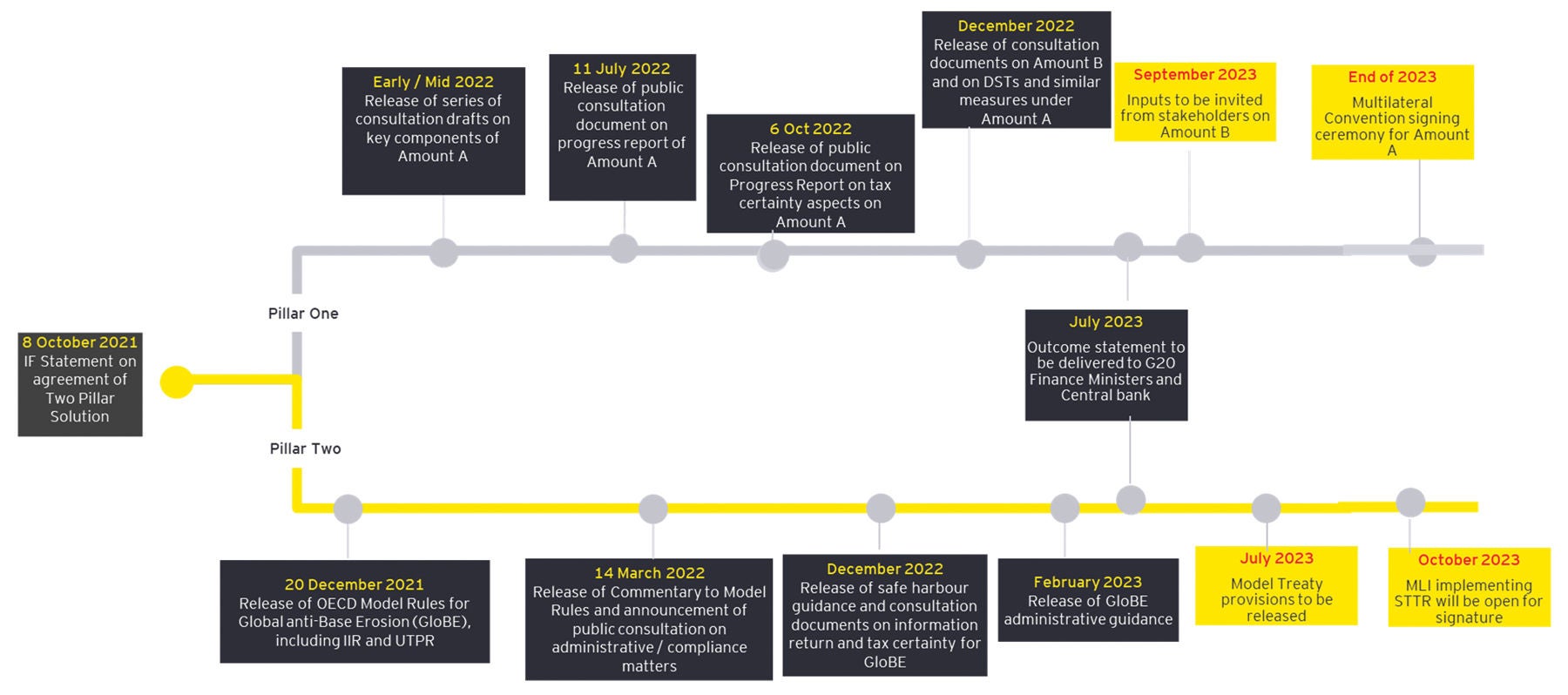EY refers to the global organization, and may refer to one or more, of the member firms of Ernst & Young Global Limited, each of which is a separate legal entity. Ernst & Young Global Limited, a UK company limited by guarantee, does not provide services to clients.

Members of the Organisation for Economic Co-operation and Development (OECD)/G20 IF on Base Erosion and Profit Shifting have delivered a package to further implement the Two-Pillar solution.
There has been constant debate on whether international income tax rules, developed in a ‘brick-and-mortar’ era more than a century ago, remain fit for purpose in the modern global economy. While a lot of work has been done under BEPS 1.0 to address some of the issues, the Organisation for Economic Co-operation and Development (OECD) released a statement in October 2021 providing an agreement of Inclusive Framework (IF) member jurisdictions on ‘Two-Pillar’ solution i.e., Pillar One (re-allocation of taxing rights) and Pillar two (global minimum taxation) of the BEPS 2.0 project, to address tax challenges arising from Digitalization. Subsequently, IF released significant agreed documents on the global minimum tax under Pillar Two, including Model Global Anti-Base Erosion (GloBE) Rules, Commentary to the Model GloBE Rules, guidance on GloBE Safe Harbors and GloBE Administrative Guidance. Further, the OECD released working drafts on the nexus and profit allocation rules under Pillar One, along with administrative aspects of Pillar Two, in the form of consultation documents.
On 11 July 2023, 138 out of 143 members (Belarus, Canada, Pakistan, the Russian Federation, and Sri Lanka did not approve the outcome statement) of the OECD/ G20 IF on BEPS came together to agree upon an Outcome Statement. The Outcome Statement is an agreement by the IF member jurisdictions on the pending elements of their project on addressing the tax challenges of the digitalization of the economy.
While the global minimum tax framework under Pillar Two is already a reality with several jurisdictions commencing the process towards implementation, the IF is finalizing the work on Pillar One and Subject to Tax Rule (‘STTR’) and its implementation framework.

Chapter 1
July 2023 statement
The statement provides a summary of the package of deliverables developed by IF to address the pending elements.
This statement provides a summary of the package of deliverables developed by the IF to address the pending elements of the Two-Pillar Solution. It comprises of the following four parts:
a. Multilateral Convention on Amount A of Pillar One
Amount A of Pillar One is a taxing right for market jurisdictions with respect to a defined portion of the residual profits of the largest and most profitable Multinational Enterprises (MNEs) operating in their markets. The text of the Multilateral Convention (MLC) has been delivered which will allow the parties to the MLC to exercise a domestic taxing right (Amount A of Pillar One) with respect to a defined portion of the residual profits of MNE that meet certain revenue and profitability thresholds and that have a defined nexus to the markets of these parties.
The MLC outlines the substantive features necessary for it to be prepared for signature, including various provisions intended to address the particular circumstances of developing countries. A few jurisdictions have expressed reservations with respect to certain aspects in the MLC and efforts are underway to resolve them. The MLC will be opened in the second half of 2023 and a signing ceremony will be organised by end of 2023, with the objective of enabling the MLC to enter into force in 2025.
Additionally, the signatories have committed to refrain from imposing newly enacted Digital Services Tax (DST) or relevant similar measures as defined in the MLC, on any company between 1 January 2024 and the earlier of 31 December 2024 or the entry into force of the MLC.
Source - Outcome Statement on the Two-Pillar Solution to Address the Tax Challenges Arising from the Digitalisation of the Economy (11 July 2023) (oecd.org)
b. Amount B of Pillar Two
Amount B of Pillar One provides a framework for the simplified arm’s length principle for baseline marketing and distribution activities which are most often litigative due to unavailability of appropriate local market comparables. The July 2023 statement indicates that agreement has reached on various aspects of Amount B framework. However, further work will be undertaken on specific aspects:
- An appropriate balance between a quantitative and qualitative approach to identify baseline distribution activities.
- The appropriateness of the pricing framework, the application of same to wholesale distribution of digital goods, country uplifts within geographic markets, and the criteria for using a local database in certain jurisdictions.
The final agreement is intended to be incorporated into the OECD Transfer Pricing Guidelines by January 2024.
c. Subject to Tax Rule (STTR) of Pillar Two
The STTR is a taxing right to developing countries on defined intra-group payments that have corporate income tax below 9% on such payments in resident country. The STTR allows that source jurisdiction to tax it at a rate up to the difference between 9% and the nominal corporate income tax rate of the residence jurisdiction. The July 2023 statement indicates that STTR is critical to achieving consensus on Pillar Two for developing IF members.
The STTR model provision and commentary have been completed and delivered. The statement also suggests that work has been completed on a Multilateral Instrument (MLI) together with an Explanatory Statement to enable implementation of the STTR, which will be open for signature from 2 October 2023.
d. Implementation support
The IF has called upon the OECD Secretariat to prepare an action plan to support the coordinated implementation of Pillars One and Two. In particular, the plan should provide additional support and technical assistance to enhance the capacity necessary for the implementation of the Two Pillar solution by developing countries in coordination with relevant regional and international organizations.

Chapter 2
Overall timelines
Stringent timelines for implementation and progress made thus far.
While there has been a clear political will to implement the Two-Pillar approach, the stringent timelines for implementation and progress made till date have been depicted below:

Source - Action 1 - OECD BEPS and https://www.oecd.org/tax/beps/news-events/events/

Chapter 3
Key considerations for MNEs
MNE groups to keep a close watch on developments in order to be able to adapt quickly.
Keeping a track of significant developments
While significant work has been completed on Pillar Two, the statement indicates that there are still some facets of Amount A and Amount B of Pillar One that need to be addressed. The statement suggests that the IF proposes to conclude on Amount A by the end of 2023 seemingly without any further public consultation. Considering the dynamic nature of changes that are continuously unfolding, MNE groups may have to keep a close watch on the developments in this regard and be prepared to adapt quickly. Additionally, it would also be pertinent to track local developments; for instance, the position that the Indian Government may adopt with respect to equalization levy in light of the Outcome Statement.
Impact assessment
Given the nature of changes, coupled with political will and ambitious timelines set for the Two-Pillar solution, it is critical for MNE groups to undertake an impact assessment and identify the key areas that require immediate attention. MNE groups will be required to review their operating/ business/ holding structures in lieu of the changing regulations. Further, MNEs also need to evaluate the impact on the incentives enjoyed in various countries bearing in mind the GLoBE rules. Any business restructurings and other M&A deals will need to carefully consider the changing landscape.
Stakeholder management
Tax function of any MNE group would need to engage with the relevant stakeholders internally (top management/ board of directors, etc.) and explain to them the larger consequences of the changing regulations including the tax cost for MNE groups. They also need to engage with auditors since there would be requirement of appropriate disclosure on account of such rules. Further, it needs to be ensured that consistent information is disclosed in other filings like tax transparency report, etc. as it would impact external stakeholders.
Compliance/system readiness
The changing tax landscape along with a rise in compliance requirements is increasingly adding to the need to creating a modern and agile tax and operating model. Implementation of Pillar One and Pillar Two will lead to new reporting requirements that will further need businesses to have appropriate technology to collate and analyze data. The tax and accounting teams of MNE groups will have to come together to collate and analyze data which is audit ready. Compliance with a completely new and complex set of regulations will bring its own share of challenges for MNE groups. In this regard, several MNE groups are looking to work together with experts, particularly those with strong capability in the areas of tax domain along with technology and data analytics. This helps MNE groups in focusing on tax policy-level strategic functions.
This article first appeared on taxsutra.com on 18 July, 2023.
Summary
OECD’s BEPS 2.0 project is a substantial transformation of the Global taxation landscape. While progress of Pillar Two, i.e., Global minimum taxation of 15%, has moved much ahead, MNEs are grappling with Pillar 2 impact and requirements which is likely to be effective from 2024. Further, while the progress on Pillar 1 has been quite slow but with the ambitious timelines of end of 2023 (i.e., 6 months for MNEs to be prepared), it is now utmost important for MNEs to take immediate steps to evaluate impact, track ever-evolving changes to be best prepared for an evolving global tax landscape.
Related articles


